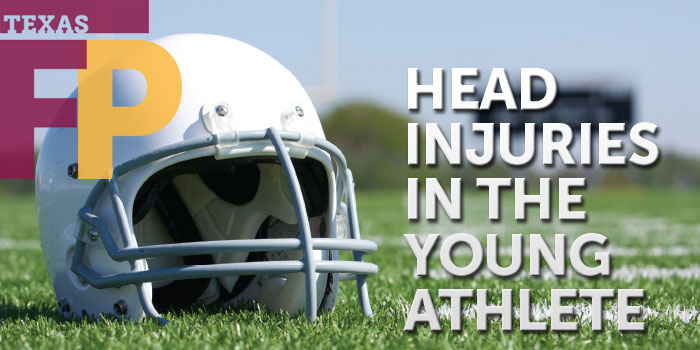Head injuries in the young athlete

Walter L. Calmbach, M.D., M.P.H.
Department of Family and Community Medicine, UT Health Science Center at San Antonio
Mark Hutchens, M.D.
Texas Sports and Family Medicine, Austin
Background—Approximately 30 million children and adolescents participate in organized sports in the U.S. each year, and between 1.6 and 3.6 million young athletes suffer a concussion each year. As many as 53 percent of high school athletes report a history of at least one concussion, and 36 percent of college athletes report a history of multiple concussions.(1)
Higher risk for young athletes—To make matters worse, children seem to be more vulnerable to the effects of brain injury than adults. After concussion, there are specific changes at the cellular level resulting in a “metabolic mismatch”: increased glucose utilization and reduced cerebral blood flow. A full description of the pathophysiological cascade that occurs after concussion is beyond the scope of this brief article, but an excellent summary can be found in the Jan. 15, 2012, issue of American Family Physician.(2) Physicians must be aware of the athlete’s increased vulnerability to injury during the recovery period, which typically takes 7-14 days.(1)
Concussion as a functional disturbance—After a blow to the head or helmet, the athlete commonly experiences the rapid onset of usually short-lived neurological impairment. These include a range of clinical symptoms that may or may not involve loss of consciousness. The symptoms could be very subtle, such as lack of focused concentration or balance disturbance. Typically, these symptoms resolve spontaneously. It is important to recognize that these acute clinical symptoms reflect a functional disturbance rather than structural injury. Because of this, neuroimaging studies are typically normal.(3)
Major paradigm shift—Over the past few years, concussion management has undergone a major paradigm shift. In the past there was an overreliance on published guidelines, which were not uniform, lacked prospective validation, and over-emphasized loss of consciousness as a marker of severity. However, published guidelines remain useful as a starting point when evaluating athletes. Importantly, outdated guidelines once allowed for same-day return-to-play, but the new consensus is that there is no same-day return-to-play for an athlete with a concussion.
We now recognize the broad individual variation in presentation and recovery after concussion. Therefore, sports medicine physicians recommend individualized management based on the athlete’s signs and symptoms, guided by routine use of standardized assessment tools. Some of these common assessment tools include the Standardized Assessment of Concussion (SAC), the Sports Concussion Assessment Tool v2 (SCAT2), the Balance Error Scoring System (BESS), and computerized tools such as the Immediate Post-concussion Assessment and Cognitive Testing (ImPACT).(4) The SAC is a simple paper-and-pencil scoring tool that helps the physician assess orientation, immediate recall, common neurological symptoms, concentration (both numbers and months), and delayed recall. The athlete receives a total score that guides diagnosis, management, and return-to-play decisions.
Neurocognitive testing—Tools such as ImPACT measure concussion-related symptoms, verbal and visual memory, processing speed, and reaction time. They can be administered online for individuals or groups, and can store data for repeat testing. They can objectively evaluate post-injury status, and track recovery for safe return to play, especially if baseline testing is present. Neurocognitive testing is useful as one component of the evaluation, but should not be used by itself to manage or make return-to-play decisions. It can be helpful in the overall management along with past history, co-morbid states, symptoms, physical exam, and social environment.
UIL changes, standardized return-to-play protocol – House Bill 2038 initiated significant changes to the Texas Education Commission section 38, specifically mandating the creation of a concussion management team at each UIL-aligned school district. One of their tasks will be to create a return-to-play protocol that describes in detail the steps an athlete must follow before they are allowed to resume full athletic competition. The UIL also requires a “Concussion Acknowledgement Form” to be signed by the student and parent or guardian, as well as a “Concussion Management Protocol Return-to-Play Form,” to be signed by a school official and the parent or guardian.
No such thing as a “minor head injury”—Physicians should take every concussion seriously. The concussed athlete has a decreased ability to process new information, and the degree of their impairment is proportional to the severity of the injury. Moreover, symptoms worsen with repeated injury (the so-called “cumulative concussion”). Thus, no head injury is minor; all need prompt evaluation before return to play.
In summary—Sports-related concussion is common, accounting for 5.5 percent of all injures. Family physicians must be aware of the special circumstances of the young athlete, who are at greater risk of injury, and tend to recover more slowly than adults. When possible, preseason baseline cognitive assessment is recommended (e.g., with the paper-and-pencil SAC or the computerized ImPACT or similar program). When managing an athlete post-concussion, the physician should follow a structured follow-up and return-to-play protocol. Finally, as primary care physicians we have a special responsibility to protect young athletes: “When in doubt, sit them out.”
Online resources
- Centers for Disease Control
www.cdc.gov/concussion/ - National Collegiate Athletic Association
www.ncaa.org/wps/wcm/connect/public/ncaa/health+and+safety/concussion+homepage/concussion+landing+page - American Academy of Pediatrics
http://pediatrics.aappublications.org/content/126/3/597 - University Interscholastic League
www.uiltexas.org/health/info/concussions
References
- Lovell MR, Fazio V. Concussion management in the child and adolescent athlete. Curr Sports Med Rep 2008; 7(1): 12-15.
- Scorza KA, Raleigh MF, O’Connor FG. Current concepts in concussion: evaluation and management. Am Fam Phys 2012; 85(2): 123-132.
- American College of Sports Medicine. Concussion (mild traumatic brain injury) and the team physician: a consensus statement. Med Sci Sports Exerc 2006; 38; 395-399.
- Halstead ME, Walter KD. Clinical report – sport-related concussion in children and adolescents. Pediatrics 2010; 126(3) 597-616.